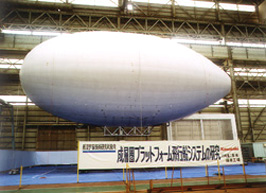Stratospheric Platform Airship Passes Performance Test
Jul. 02, 2001
Kawasaki recently delivered a test model airship to the National Aerospace Laboratory of Japan, following successful lift control performance testing on the model at the Harima Works, where it was fabricated.
When deployed, the stratospheric platform (SPF) airship will be a huge, unmanned craft, floating at an altitude of about 20 km with ahost of communications equipment and observation sensors onboard.
The SPF will be used for earth observation and disaster monitoring, as well as providing infrastructure for broadband Internet, digital broadcasting, cellular phone and other means of mobile communications. Closer monitoring of marine, land and atmospheric conditions is also anticipated.
The SPF Project is jointly promoted by Japan's Ministry of Public Management, Home Affairs, Posts and Telecommunications and the Ministry of Education, Culture, Sports, Science and Technology.
The project includes the Stratospheric Platform Development Association, a consortium comprising government, business and academia.
Kawasaki's model airship is 21.5m long, 10.2 m high and weighs 450 kg. Unlike conventional airships, it has a multiple-cell structure, with each of its three cells containing blowers and exhaust valves that draw air in and out of the shell to control the altitude and attitude. The lightweight, durable shell is an airtight membrane made of a new high-performance fiber called ZYLON®.
The lift control performance test verified the integrity of the multiplecell design. The next stage will be geostationary control testing of a 60 m model at a low altitude of 4km, scheduled for 2003.






